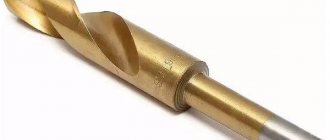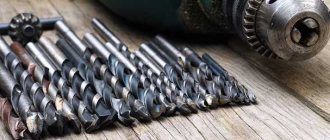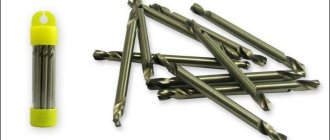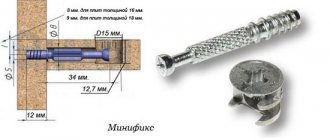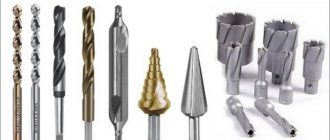A drill is a common cutting tool that is used not only to produce through holes by drilling, but also to increase the size of existing ones.
Technically, the products are attachments for hand drills, hammer drills and various machines.
Drilling itself involves removing material through the rotational movement of a sharp cutting edge.
The instrument is divided into a huge number of types according to its shape and purpose.
Metal drills: external differences
A drill is designed as a tool capable of making a hole in solid metal (concrete, tile, wood). Therefore, it has a special design that can overcome the resistance of the metal layer; There are three parts in any drill.
The cutting part is the first to come into contact with the material in which the hole is made. Behind the cutting blade there is a working part that helps remove chips. The back part is also called the shank or fastening part; it is fixed in the drill chuck. The question of what types of drills there are can be answered based on their appearance; There are several types of cutting tools.
Flat (feather)
The working part is solid or with replaceable cutting plates, narrow, reminiscent of a feather (hence the name). Allows you to drill stepped and shaped holes. The device has a simple design and is inexpensive. But with its help it is difficult to drill a wide hole, and the chips must be removed manually.
Prefabricated feather drills for metal Source prom.st
Spiral
The most common type is in the form of a rod with two (less often four) spirally cut grooves through which chips are removed. If the spiral grooves twist to the left, then this is the left-handed variety, which will help remove the fastener. There are products of a higher accuracy class, but in everyday life, spiral cylindrical drills of normal accuracy with a diameter of up to 82 mm are more often used.
Design of a twist drill Source kerner.ru
Crown (ring, hollow)
They have the appearance of a hollow cylinder, are more efficient (fast) and less expensive than spiral models. Feature: material is removed along the periphery of the hole (in). Core bits are especially useful when it is necessary to drill into curved surfaces (such as pipes).
Metal annular cutter for magnetic drills Source snabzhenie.com.ua
Countersink
It has a conical working part with longitudinal cutting notches (there can be 3 or more cutting edges). Used where high precision is required, especially in mechanical engineering. Countersinking is more often used to clean the surface before cutting threads and to calibrate holes.
Drill with countersink for metal Source stroy-podskazka.ru
Conical (stepped)
The working part is in the shape of a cone with notches that allows you to create and expand holes. Thanks to the complex stepped surface, the tool is easier to center than its spiral counterpart, which is especially convenient when working with thin material. Each stage corresponds to a specific diameter, which allows you to obtain holes of different sizes without changing the drill bit in the drill chuck.
Step metal drill with helical flute Source amazon.com
See also: Catalog of companies that specialize in finishing materials and related work
Drill characteristics
The main characteristic of any drill is its strength, which should exceed this indicator for the material being processed.
The tool, depending on the conditions of use, has different sizes and shapes.
The sharpening angle of the cutting part, color, etc. also differ.
Each product has a shank, the type of which must match the chuck of a drill, screwdriver or machine.
Material
For the manufacture of drills, alloys with different characteristics are used.
In this case, the so-called “high-speed” steel grades P18, P9, P9K15 are used.
If the diameter of the drill exceeds 8 mm, a welding method is used in its manufacture, for example: carbon steel for the shank, high-speed steel for the working part.
For materials with high hardness (mainly metal), cobalt drills are usually used.
Their peculiarity is that the working part is made from high-speed steel R6M5K5, VK6M with the addition of cobalt.
NOTE
After the letter “K” in the marking there is always a number that indicates the amount of cobalt in the parts.
Carbide Pobedit drills are used for drilling concrete, stone and brick.
The tip of such a tool is tipped with pobedite, an alloy of tungsten (90%) and cobalt (10%), developed in the USSR. There are more than ten modern modifications of this alloy.
IMPORTANT!
The pobedite tip does not cut the material, but crumbles it, so it is not suitable for working with metal, plastic and wood.
In addition to tungsten and cobalt, chromium, molybdenum, and vanadium are found in the alloys, and their percentage is indicated in the marking.
Coating
To extend the life of drills, their body has one of the following coatings:
• Oxide film – significantly increases resistance to overheating from friction.
Also protects the product from rust.
The service life naturally increases.
• Diamond coating is the most durable coating available.
It is mainly used on those products that are used when working with extremely hard materials, including stone and porcelain stoneware.
• Titanium coating is a general name indicating that the material contains a chemical compound of titanium - TiN (titanium nitride), TiAIN (titanium aluminum nitride), TiCN (titanium carbonitride).
Coloring
The color of the drill is very important.
It indicates the coating used or processing method:
• Gray is the native color of steel.
Indicates the absence of any processing.
The cheapest and most short-lived products are gray in color.
• Black is the color of steel that has been exposed to superheated steam during finishing.
Black products are much more durable than the previous option.
• Yellow is the color of steel that has been tempered (processing of metal to relieve its internal stress).
It speaks of the high hardness of steel, and its brittleness is greatly reduced by tempering.
• Golden – the color of titanium nitride. Bright golden tools are very durable, and they also have reduced friction against the workpiece.
Dimensions and weight
Manufacturers of cutting tools offer an impressive range of drills of every possible “caliber”, depending on the design and purpose.
Let's look at the most common spiral products according to GOST:
- Short: 20 – 131 mm in length, 0.3 – 20 mm in diameter (GOST 4010-77);
- Extended: 19 – 205 mm in length, 0.3 – 20 mm in diameter (GOST 10902-77);
- Long: 56 – 254 mm in length, 1 – 20 mm in diameter (GOST 886-77).
As for the exact weight, it depends not only on the design of the products, their sizes, but also on the material of manufacture.
The weight of ordinary twist drills usually ranges from several units to several tens of grams.
Processing accuracy
For twist drills there is such a characteristic as accuracy class:
- A - increased accuracy (10 - 13 qualifications);
- B1 – normal accuracy (up to 14 qualifications);
- B – normal accuracy (up to 15 qualifications).
Quality is a characteristic of accuracy that determines the tolerance values.
Shank
Different models of tools have different types of fastening, therefore, before choosing a drill for metal, it is worth checking the fastening method. Products are selected for the type of fastening of a specific drill. The following shank options are common:
- Cylindrical. A widely used option, used for fixation in key drill chucks. The advantage of a cylindrical shank is that it almost never jams, but due to its smooth shape it sometimes slips in the chuck.
- Hexagonal. The edges of the shank are rigidly positioned in the grooves of the three-jaw chuck. When rotating, the drill is held firmly in the chuck and does not rotate.
- Conical. A truncated cone shank is often found in drilling machine tooling. Sometimes the shank is threaded to improve retention.
Cylindrical and hexagonal shank Source instrumentgid.ru
Criterias of choice
The appearance (structural form) determines the method of use of the drill. But when choosing equipment for drilling, be sure to take into account the following indicators:
- Material of manufacture. The composition of the alloy determines the performance characteristics of the part.
- Is there any additional processing? The cutting surface is often enhanced by spraying.
- Performance characteristics, including the main diameter, shape and sharpening angles.
Material, color and processing
A hole in a part made of any metal or alloy can only be made by a tool with a harder structure than the surface being processed. Therefore, the raw material for the best metal drills is high-speed steel, which retains its properties at high temperatures. You can verify this by the marking: the product will have the letter “P” or the abbreviation HSS.
Different colors - different characteristics Source nikastroy.ru
HSS is not one grade, but a whole class of steels that differ in additives. Usually tungsten, cobalt and molybdenum are added, which is indicated in the labeling. For example, K6 indicates the presence of cobalt in the alloy (the number indicates the content, 6%). This additive increases the service life of the drill three times, and it can work with particularly strong grades of steel.
When choosing a drill for metal, it is necessary to take into account the type of coating, which changes the characteristics of the equipment. For example, a surface layer of sputtered titanium nitride (HSS-TiN) increases the hardness and heat resistance of the working area during drilling.
The surface layer of titanium nitride alloyed with aluminum (HSS-TiAlN) extends the service life of the product by 5 times; wear resistance is maintained when heated to 600-700°C. This is a universal tool, but is not often found in construction stores. The HSS-G marking indicates that the cutting part of the drill is ground with cubic boron nitrile. The tool is popular because it drills hard grades of steel and is relatively inexpensive.
A spear-shaped drill with a titanium-tungsten tip is also suitable for drilling ceramics Source dnipro-m.ua
Types of drills for concrete
Screw
Twist drill bits are visually similar to bits for metal and wood. They also have a cutting edge and a groove for carrying concrete chips out. The only difference is in the tip. It can be pobedite or diamond coated. This tip drills well into concrete, brick, cinder block and other cementitious materials.
Concrete drills are made in most cases for a hammer drill, so most of them have a hex shank for an SDS chuck.
Spiked
This type of drill is characterized by the presence of a cylindrical lance and a tip similar to the tip of a spear. The tip is made with diamond coating, so it can be used to drill particularly durable materials. These drills are designed for drilling small holes in stone. However, the drilling itself is quite long and can take several minutes. Some nozzles have grooves for removing stone chips, while others do not. Such a drill is only needed for drilling stone - for other purposes it is better to take a regular screw one.
Crowns
The largest drills designed for drilling large holes in concrete. They are a hollow crown with a serrated edge. In the center there is a drill, which is drilled into the concrete and centers the entire nozzle throughout the work. If you need to drill an ideal large hole in brick or concrete, for example, for a water pipe or cable duct, then a crown is the ideal option.
About the manufacturers
The answer to the question of which metal drills are the best depends on the volume of work and on what material to be performed. The market is saturated with products from famous and unnamed companies, but if you are looking for a reliable tool that will not break after the first use, pay attention to what famous brands offer.
Among foreign manufacturers, the products of the German concern Bosch are famous. The company produces drills and sets for household and professional use. The products are characterized by high performance characteristics and a long service life. The professional tool is produced by the Japanese company Makita. Its products are resistant to damage and demonstrate high drilling speed.
Among domestic companies, the most notable brands are Zubr, Enkor, and Interskol, which specialize in inexpensive, high-quality tools. Metal-cutting tools from the GRIFF, Praktika, and Ataka brands have a good price-quality ratio.
Sets of drills of different types and purposes are popular Source amazon.com
Briefly about the main thing
Metal drills are one of the most popular tools in construction practice, but, unfortunately, they are not universal. In order not to spoil the work, it is important to choose the right drill, and for this you need to understand what criteria describe its characteristics.
The choice is based on the shape of the cutting part, not forgetting the shank and sharpening angle. The selection parameters are material, color, diameter and size; important information can be gleaned from the labeling. If you expect to work for a long time, pay attention to well-known brands that offer better sharpening, heat resistance, and wear resistance.
Ratings 0
How to choose a drill
When choosing a good drill for your home, you should focus on the color of the product, its size, and manufacturer.
As for shanks, one of the following options occurs:
- Cylindrical (for drills);
- Conical (Morse shank);
- SDS type (for rotary hammers);
- Triangular (for hand drills), tetrahedral, hexagonal (hex for screwdrivers and drills).
When choosing a drill for professional activities, the following will be useful:
• Marking is a combination of letters and numbers indicating such parameters as diameter, steel hardness, impurities in the alloy, place of production and its technology.
NOTE
The marking is placed on products whose diameter is more than 2 mm.
• Sharpening angle – differs for different materials and is the angle between the cutting edges.
The ease of drilling and speed depend on it.
